Appendix N. Part 1—Transport, Leak Testing, Cleaning: Transcript/Facilitator Notes - Implementation Guide
Slide 1: Appendix N. Part 1: A Clear View of Flexible Endoscope Processing: Transport, Leak Testing, Cleaning
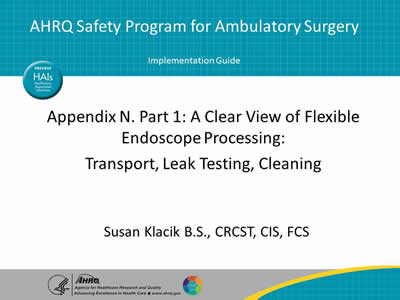
Hi, and welcome to this presentation on a Clear View on Flexible Endoscope Processing. There's two modules with this set. In this module, we will be discussing the transport leak testing and cleaning of flexible endoscopes.
Slide 2: Objectives
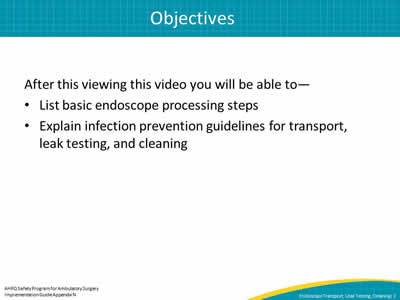
The objective of this presentation is that after this presentation you will be able to list the basic endoscope processing steps and explain the infection prevention guidelines for transport, leak testing, and cleaning flexible endoscopes.
Slide 3: Resources
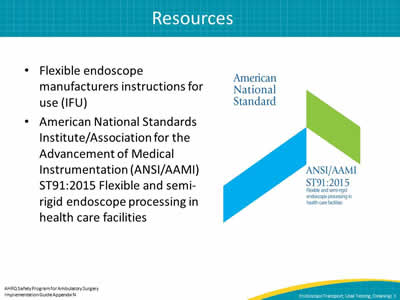
When processing flexible endoscopes, the first thing to do is to consult the manufacturer's written instructions for use. This comes with each and every flexible endoscope and rigid endoscope that you purchase. Also, all medical devices do have instructions for use that you need to follow. Since we're discussing flexible and semi-rigid endoscopes, we're also going to be referring back to the ANSI/AAMI ST91 document that was published in 2015. An endoscopy suite or any place that does process flexible and semi-rigid endoscopes should have this document in their facility because it provides a lot of great information and resources to consult. A majority of this presentation is based off of this document.
Slide 4: Basic Endoscope Processing Steps
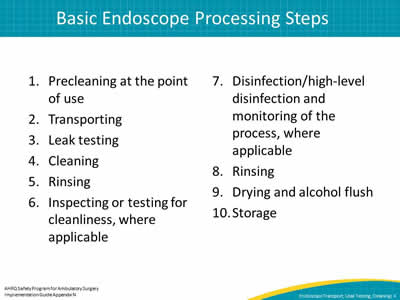
When processing endoscopes, there are some very basic steps that we follow. The precleaning at the point-of-use, the transporting, leak testing, cleaning, rinsing, inspecting or testing for cleanliness. There's disinfection, rinsing, drying, alcohol flushing, and storage. In these steps, although there's only ten*listed, inside each one, as you know, there's quite a few steps. When processing flexible endoscopes, it's easy to get up over 120 steps per scope, so it's important that training is followed [for each and every scope].
*audio states seven, but ten is correct as per the slide
Slide 5: Point of Use Precleaning IFU
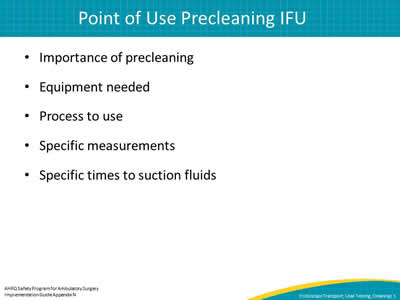
Let's start with the very beginning, the point-of-use precleaning, and this is in the instructions for use. With flexible endoscopes, they start the process right at the point of use, and they talk about the importance of precleaning, and also the instructions for use will provide you with a list of the needed equipment to perform this, and also how to process the scope at the point of use. The instructions for use may tell you specifically what type of syringe to use, what type of cleaning solution and how much cleaning solution to use, if there's any specific measurements. And some instructions for use may actually provide a specific amount of time that you need to suction the fluids through the flexible endoscope.
Slide 6: Point of Use Precleaning ST91
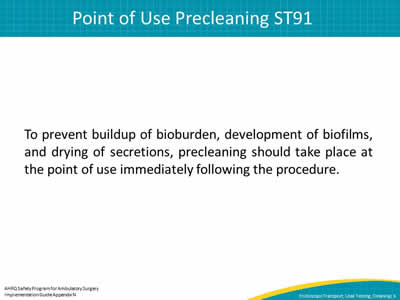
In the AAMI ST91 document, we talk about the importance of precleaning at the point of use. The purpose of this is to prevent biofilm buildup. Biofilm starts to form in as little as 5 to 10 minutes after use. Once this biofilm starts, it's almost impossible to remove it, so to prevent the buildup of bio burden, the development of biofilms and drying of secretions, precleaning should take place at the point of use immediately following the procedure.
Slide 7: Transport of Used Flexible Endoscopes
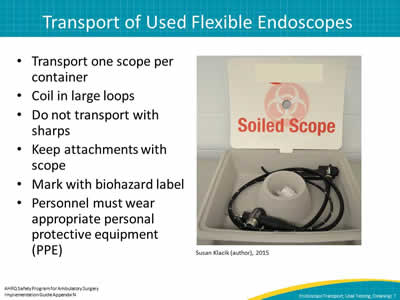
When transporting flexible scopes after use, it's important to transport them appropriately. The scopes should be transported one per container. When a scope leaves a patient care room and is then transported for cleaning, it needs to be covered, and it should be transported one scope per container. To prevent damage to the scopes, the recommendation is that the scope is coiled in large loops to prevent breaking of the fibers. They should not be transported with sharps because sharps could cut the flexible endoscope. We are now recommending that attachments are kept with the scope throughout the entire process. To alert other personnel in the area, it's important that the used scope is marked with a biohazard insignia. That way it alerts everybody that this scope is contaminated and not to use it. It also prevents somebody from reaching in with their bare hands onto the scope and becoming contaminated. During transport, personnel should wear the appropriate personal protective equipment or PPE.
Slide 8: Transport of Used Scopes - Continued
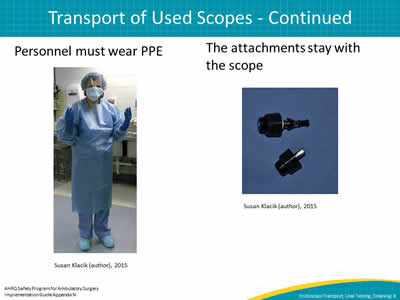
When transporting the scope, again, personnel should wear appropriate PPE, and something new is that the attachments now stay with the scope. Previously, that has never been mentioned, but with the release of the AAMI ST91 document, it specifically states that attachments need to stay with the scope through the entire process.
Slide 9: Leak Testing IFU
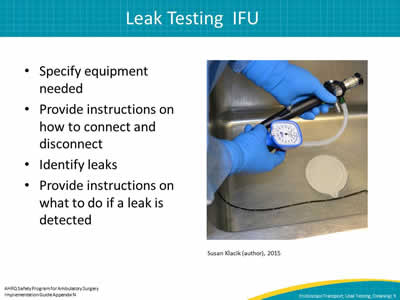
In the instructions for use, the manufacturer talks about leak testing. During the leak testing process with the instructors for use, the manufacturer once again specifies the equipment needed to perform leak testing. There are different types of leak testers available, so when performing leak testing on a scope, each specific scope has its own special type of leak tester. The instructions for use will also provide instructions on how to connect and disconnect the scope to prevent damage to the scope and to make sure that you're performing leak testing correctly.
The purpose, of course, is to identify leaks. If there is a leak in the flexible endoscope, that could lead to further damage to the scope, and in addition it can lead to bacteria being given a place to hide in the scope, which could later result in an infection. So, again, the purpose of leak testing is very vital. During the leak testing we want to make sure that there are no leaks in the scope, because leaks can cause a breach in the sheath of a flexible endoscope, thereby providing a place for bacteria to hide and multiply. In addition a leak in a scope can also result in further damage to the scope. If a scope does have a leak, it's important to identify that leak immediately and to pull it out of the service and to send it out for repair. In the leak testing instructions for use, the manufacturer will provide instructions on what to do if a leak is detected.
Slide 10: Leak Testing ST91
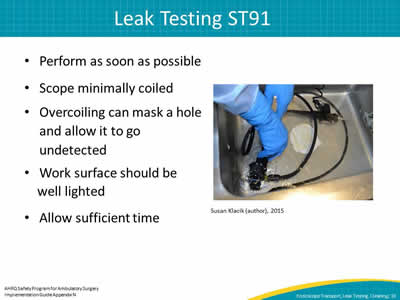
In ST91, we also talk about leak testing, and it pretty much mirrors what the manufacturer says. It talks about performing leak testing as soon as it arrives in the processing room, and it goes into a little more detail, talking about not coiling the scope too tightly. The reason for that is, by having the scope in a large coil, if bubbles are the way to identify leaks you can see the bubbles easier, and overcoiling can mask a hole and allow the leak to go undetected. In the leak testing section of ST91, it also talks about having a very well-lit work surface so that we could see if there is a leak. ST91 also talks about having sufficient time to process the scope, looking for the leaks in the scope.
Slide 11: Manual Cleaning IFU
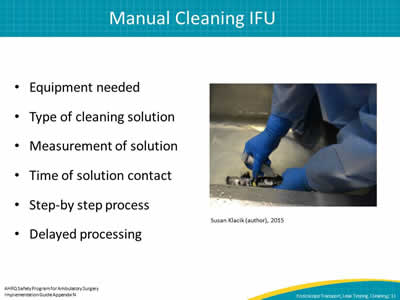
When performing manual cleaning with the IFU, the manufacturer will, once again, provide the equipment needed, and they will specify the type of cleaning solution to use and also a method to measure the cleaning solution. It's important when we're processing a flexible endoscope that the cleaning solution contacts the entire inner channel of that flexible endoscope. So, at this point, when the manufacturer provides a specific amount of solution to be flushed through their flexible endoscope, it’s important that that is exactly what is followed. If not enough solution is pushed through these channels of the flexible endoscope, you may not get the adequate contact of the cleaning solution and thus get inferior cleaning. So, again, the manufacturer will provide specific instructions on how to flush the solution through the scope. They provide a step-by-step process.
Also in the manual cleaning part of the instructions for use is delayed processing. What delayed processing is is, if a scope is not processed immediately, perhaps the wait’s a half hour to an hour, the manufacturer will provide specific instructions on how to then process that scope by the delayed process. They may have the user in the endoscopy lab soak it for a certain amount of time. Maybe the soaking needs to be extended 2 to 3 hours. It varies and it's dependent upon the manufacturer's instructions for use. But that's a very important component of processing flexible endoscopes, and as you see over and over again, it is important that the flexible endoscopes are processed as soon as possible. That's why that point-of-use cleaning is so vitally important, why they need to be transported immediately to the work room for processing, to the point that the manufacturers have identified delayed processing as an additional step if processing is not performed in a timely manner.
Slide 12: Manual Cleaning ST91
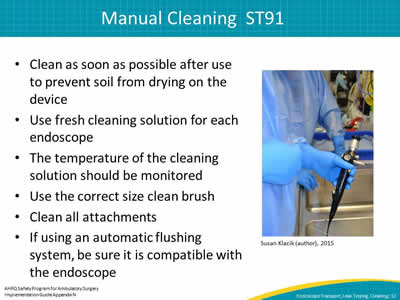
In the AAMI ST91 section of manual cleaning, they too talk about cleaning as soon as possible after use to prevent soil from drying on the device. Once again, we're concerned about the buildup of biofilm. Also in ST91, they talk specifically about the cleaning solution, stating that each scope gets its own fresh cleaning solution, so scopes cannot be cleaned in the same bath. Every scope gets its own bath.
It also talks about monitoring the temperature of the cleaning solution. When performing cleaning, the enzymatic detergent manufacturer will specify a temperature range for the cleaning solution, so it's important that that is monitored. The temperature range, it may be between 90 and 120, so as a user we have to monitor our cleaning solution to make sure that we do have the correct temperature. Also, the detergent manufacturer specifies a certain dilution. It may be 1 ounce per gallon. It's important that, too, is measured. What a lot of facilities do is put a line in the sink, and then if it is 1 ounce per gallon, they may have a mark per every gallon and then use a 1-ounce cup for measuring. So, it's important for our cleaning solution that we're using the correct temperature and that we have the correct dilution.
Also, using the correct size of cleaning brush. The cleaning brush is specified in the manufacturer's instructions for use. If the cleaning brush is too small, it is not going to get all edges inside of the cleaning of the channel. If the cleaning brush is too large, it can actually scratch and dent the inner channels, thereby providing an area for bacteria to grow and to multiply. Some manufacturers also specify a specific type of brush, you know, a nylon brush or a soft bristle brush. So, it's important that we follow that.
We need to clean all attachments during the manual cleaning phase, so as we're cleaning the scope, all of the attachments also need cleaned at this point and, again, the attachments stay with the scope. If using an automatic brushing system, the first thing we need to make sure that it is compatible with the scope. So, we need to refer back to the scope manufacture and find out that we can in fact use this cleaning, flushing solution with that scope, because, again, we want to make sure that the cleaning solution is getting to all surfaces of that inner channel.
Slide 13: Rinsing IFU
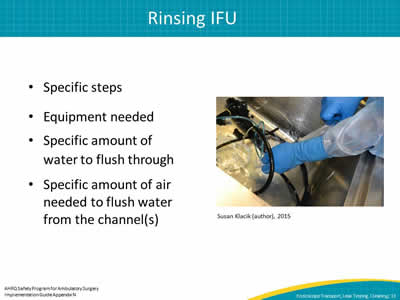
Next we're going to talk about rinsing. Rinsing is a very important part of the process also. In the scope manufacturer's introductions for use, once again, they will provide specific steps for rinsing. They will, once again, talk about the equipment that is needed, because, again, we need to make sure that we're going to get to all inner surfaces of the flexible endoscope. They will provide a specific amount of water to flush through the channels, and after that they'll also provide a specific amount of air needed to flush water from the channels. It's important to note here, when using pressurized air, medical grade air, that you're using the correct PSI because we don't want to blow out the scope channels.
Slide 14: Rinsing ST91
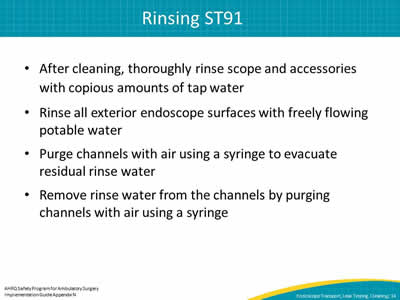
When rinsing according to the AAMI ST91 document, they get a little more deep into it, talking about after cleaning, thoroughly rinse the scope and accessories with copious amounts of tap water. We need to remove all of detergent residues from the scope. If we have detergent residues left in the scope, it can actually interfere with, further on down the line, the high-level disinfection or sterilization processes. At this point, the rinse step is very, very important. Again, we need to follow the manufacturer's instructions for use. Make sure you have a good water quality going into the rinse cycle.
When we're manually rinsing, we need to copiously rinse the internal parts of the scope. Tap water is fine, but, again, it needs to be a good quality tap water. You need to rinse all exterior endoscope surfaces with freely flowing potable water, which is tap water, purge all channels then with air, using a syringe to evacuate residual rinse water. We need to get the rinse water out because the next step, which is going to be either high-level disinfection or sterilization, we do not want the water to dilute the next step of, again, sterilization or high-level disinfection. Removing the rinse water from the channels by purging the channels with air by using a syringe.
Slide 15: Inspecting for Cleanliness
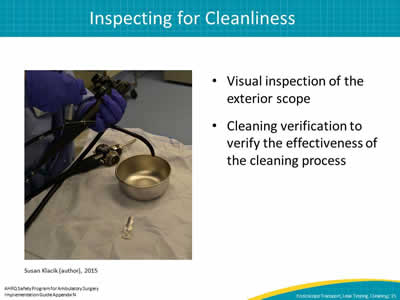
Next, inspecting for cleanliness. We just talked about cleaning verification, and to inspect for cleanliness, obviously we will check the entire exterior of the scope. A lot of facilities are now using lighted magnification glasses, and that's a great recommendation because you can see far more with a lighted magnifying glass. There's also cleaning verification to ensure the effectiveness of the cleaning process. The cleaning verification occurs at the end of the cleaning prior to disinfection. If we do find that the cleaning verification test does not pass, the scope then goes back for recleaning and all the steps need to be followed, all of the cleaning and rinsing steps need to be followed. Of course, at the very end of the rinse cycle, we will then flush the scope with air, once again, to make sure that there's no residual rinse water in there, and, again, perform the cleaning verification test, because we need all of our scopes for the patients to be thoroughly cleaned prior to going into the next step.
Slide 16: References
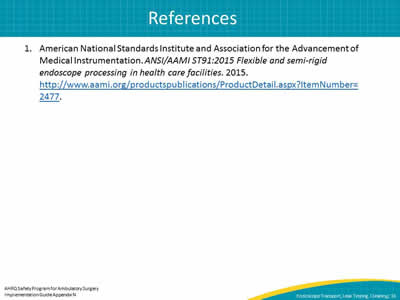
The references for this presentation have primarily come from the ANSI/AAMI ST91 flexible and semi-rigid endoscope processing in health care facilities. The other documents are the manufacturer's instructions for use, you should have in your facilities for each of your flexible endoscopes, and you need to follow those also.



